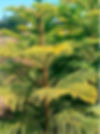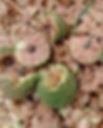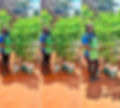The Araucaria Tree
- BeyondForest
- Dec 5, 2024
- 6 min read
Updated: Aug 21

By the end of this section you will have learnt
FAQ About Araucaria
Araucaria seeds
Benefits of Araucaria
Uses of Araucaria
Disadvantages of Araucaria
The Araucaria tree is often described as a "living fossil" because it has existed since the Jurassic period.
Araucaria araucana, commonly known as the monkey puzzle tree, Chilean pine, or pehuén, is a distinctive evergreen conifer native to the Andes mountains of central and southern Chile and western Argentina. It is the hardiest species within the Araucaria genus and serves as Chile's national tree .

The tree is admired for its peculiar, spiky branches and symmetrical form, making it a popular ornamental plant worldwide. This tree can grow up to 40 meters tall with a trunk diameter reaching 1.5 meters. Young trees exhibit a pyramidal shape, while mature specimens develop an umbrella-like crown due to the loss of lower branches .
Struggling To Grow Your Business?
Scale By Running Facebook and Instagram Ads Like This .

📩 Fill the form below to get your free consultation or demo report.
📞 Prefer WhatsApp? Click Here
The species name "araucana" is derived from the Araucanía region in Chile, where it is naturally found. The name "Monkey Puzzle" originated in England in the 19th century when someone remarked that the tree's spiky branches would "puzzle a monkey" trying to climb it.

Araucaria araucana is dioecious, meaning male and female cones grow on separate trees, although some trees may bear both types of cones.
The Monkey Puzzle tree is an ancient species, often referred to as a "living fossil" due to its evolutionary origins dating back over 200 million years. It is a slow-growing tree that can reach heights of 30–50 meters (98–164 feet) with a trunk diameter of up to 3 meters (9.8 feet). The tree has a pyramidal shape in its youth, which becomes more irregular as it matures.
Due to its resilience, it has been cultivated in various parts of the world. In Kenya It was planted at the Karura Forest back in the colonial period and was used as Fuel In Propelling the Uganda Nairobi Railway

How long does it take for Araucaria araucana to mature?
The monkey puzzle tree is slow-growing, often taking several decades to reach full maturity.
Are the Araucaria seeds edible?
Yes, the seeds (piñones) are edible and have been consumed traditionally by indigenous communities.
Why is it called the "monkey puzzle" tree
The name originated in the 19th century when someone remarked that its unique branch structure would puzzle a monkey to climb
Can I grow Araucaria araucana in my garden?
Yes If you reside in a region with a suitable climate—cool, moist conditions with well-drained soil—it is possible. However, ensure ample space as the tree can become quite large.
They are such strange trees! They became very popular with the Victorians who saw them as a curiosity.- Ventiajane's Garden

Image of Araucaria Seeds for sale a kilogram for 5000Ksh by Treetory Nursery
The spiritual meaning of the Araucaria tree, especially the Araucaria araucana (Monkey Puzzle Tree), is deeply rooted in themes of protection, endurance, ancient wisdom, and connection to the divine.The tree’s sharp, armor-like leaves symbolize spiritual protection. Just as the tree defends itself in the natural world, it is believed to ward off negative energy and harmful spirits in spiritual or metaphysical beliefs.Araucaria is often referred to as a "living fossil", having existed for over 200 million years. Spiritually, it represents timeless knowledge, ancestral memory, and the endurance of life across ages.

Araucaria (Monkey Puzzle Tree) wood is classified as a softwood, even though it comes from a large, dense, and slow-growing conifer.
What are the medicinal uses of monkey puzzle tree?
The Monkey Puzzle Tree (Araucaria araucana) is not widely known for modern medicinal use, but among indigenous communities—especially the Mapuche people of Chile and Argentina—parts of the tree have traditionally been used for nutritional and therapeutic purposes.The seeds of the tree, called piñones, are rich in carbohydrates, protein, and minerals.
What is the common name for a monkey puzzle tree?
In Kikuyu Language the Araucaria Tree is known as Moshida Nugu implying that it defeats the monkey (nugu )to climb thus the name
The value of a Monkey Puzzle Tree (Araucaria araucana) depends on several factors including its size, age, health, location, and legality of sale, as the tree is protected in its native range (Chile and Argentina) and can be rare in other parts of the world. In some regions, the Monkey Puzzle Tree is legally protected and cannot be harvested or sold without permits.
Yes, you can take cuttings from a Monkey Puzzle Tree (Araucaria araucana), but it is difficult and not always successful. This species is notoriously hard to propagate from cuttings

Is monkey puzzle wood valuable?
Yes, Monkey Puzzle wood (Araucaria araucana) is considered valuable, especially in regions where the tree is rare or protected. However, its commercial use is limited due to conservation laws and slow growth.
Telling the age of a Monkey Puzzle Tree (Araucaria araucana) can be tricky without cutting it down, but here are some practical methods to estimate its age On average, Monkey Puzzle Trees grow about 35–50 cm (1–1.5 ft) per year when young.Measure the height and use known growth rates to estimate age.
Yes, Monkey Puzzle Trees (Araucaria araucana) develop deep and strong roots, especially as they mature.
How Is it Possible that my Male Monkey Puzzle Tree has an offspring?
Vegetative reproduction as in this case isn't depended on sexual reproduction, many plants possess the ability to clone themselves without sex

Also for an epicormic shoot. They are usually suppressed by hormones. incase the top of your plant been injured recently Sometimes injuries induce release of PGRs that stimulate shoot growth.
Araucaria Seedling and Seeds Price List
The price of a small Araucaria sapling cost around 20Ksh .The cost of one kilogram Araucaria seeds cost 5000Ksh among Online vendors as well as Kenya Forest research Institute (KEFRI). For a 4 foot tall araucaria tree the cost is 500Ksh

Image of Araucaria Seedlings by BioTech KARURA
Araucaria Leaves
Male Cones are Cylindrical, elongated, and produce pollen. while Female Cones are Large, round, and contain seeds that are edible and nut-like.

The leaves are thick, tough, and triangular in shape. They are dark green with sharp, spiny edges, making them unpalatable to most animals. Each leaf can remain on the tree for 10–15 years before falling.
Araucaria araucana can live for over 1,000 years.
Araucaria Bark
Araucaria araucana is native to Chile and found in the Andes Mountains and coastal regions and Argentina where it Grows in the Patagonian forests. It thrives in temperate climates with cool, wet winters and mild, dry summers.

Araucaria bark is thick, resinous, and scaly, providing protection against forest fires and harsh weather.
Araucaria seeds
The Araucaria is Listed as Endangered by the IUCN due to threats from logging, forest fires, and grazing .

Image of Araucaria Seeds for sale a kilogram for 5000Ksh by Treetory Nursery
Araucaria seeds, often called piñones, are an important food source for local communities and wildlife. The indigenous Mapuche people of Chile have long relied on the piñones for food. The seeds are roasted, boiled, or ground into flour.
Despite being native to South America, it has been successfully cultivated in various parts of the world, including Europe, North America, Australia and Africa
Where To Buy Araucaria Seedlings

Image of an Araucaria Seedling by Landscapper Maggie
The sharp, scale-like leaves deter herbivores, making it less palatable to animals.
Biodiversity
Araucaria araucana forests provide habitat for numerous species, including birds, mammals, and insects. The seeds are a vital food source for rodents and birds like the austral parakeet.
Carbon Sequestration
Like other trees, it plays a role in capturing carbon dioxide and mitigating climate change.
Fire Resistance
Its thick bark and robust structure make it resistant to forest fires, helping maintain ecosystem stability.
Uses of Araucaria
The wood is durable and used in construction and furniture-making.
Piñones Seeds are a nutritious food source rich in carbohydrates and proteins.
Its unusual appearance makes it a favorite for landscaping due to its Ornamental Value.
Traditional remedies use parts of the tree to treat wounds and infections, although scientific evidence is limited.
The Araucaria genus comprises approximately 20 species, primarily distributed in the Southern Hemisphere

Notable species include of Araucaria Include

Image of an Araucaria heterophylla by Olive Silver on Instagram
Araucaria angustifolia | Known as the Paraná pine, native to Brazil and Argentina. |
Araucaria bidwillii | Commonly called the bunya pine, native to Queensland, Australia. |
Araucaria columnaris | Also known as the Cook pine, native to New Caledonia. |
Araucaria cunninghamii | Known as the hoop pine, found in eastern Australia and New Guinea |
Araucaria heterophylla | Commonly referred to as the Norfolk Island pine, native to Norfolk Island |
Pests and Diseases: Fungal infections and root rot can affect the health of the tree.
Slow Growth: Its slow growth rate makes it difficult to replenish populations quickly.
Climate Sensitivity: It requires specific climatic conditions, making it vulnerable to environmental changes.

